糖尿病病例分析(英文)
糖尿病(全英文版)DiabetesMellitus

Lab test
blood glucose is higher than 33.3 mmol/l, usually 33.3-66.6 mmol/l and serum osmolality > 350 mmol/l
Introduction
There are more and more people suffer from diabetes with the development of society, population aging and changes of life style.
Diabetes mellitus is a group of metabolic disorders characterized by chronic
Stage 5: clinical diabetes
Stage 6: beta cells of the clients who
have longtime diabetes are damaged
thoroughly, blood insulin level is very low
Type 2 diabetes
Type 1 diabetes
Stage 1: genetics emotivity Stage 2: start autoimmune Stage 3: immunology abnormality
Stage 4: progressive dysfunction of beta cells
gestational diabetes mellitus
糖尿病患者soap病历点评制度

糖尿病患者soap病历点评制度英文回答:Subjective:Chief Complaint: Diabetes management.History of Present Illness: The patient is a 55-year-old male with a 10-year history of type 2 diabetes mellitus. He is currently following up for routine management. He denies any acute symptoms or changes in his condition.Past Medical History: Diabetes mellitus type 2, hypertension.Medications: Metformin 500 mg twice daily, amlodipine5 mg daily.Social History: The patient is a married father of two. He works as a teacher. He is a non-smoker and drinksalcohol socially.Family History: The patient's father has a history of type 2 diabetes mellitus.Objective:Vital Signs: Blood pressure 130/80 mmHg, pulse 72 beats per minute, respirations 16 breaths per minute, temperature 98.6°F (37°C)。
Physical Exam: The patient is in no acute distress. He is obese with a body mass index (BMI) of 32. His skin is warm and dry. His head and neck are unremarkable. His chest is clear to auscultation bilaterally. His heart sounds are regular and S1 and S2 are present. His abdomen is soft and non-tender. His extremities are warm and well-perfused.Laboratory Data: A1C 7.2%, fasting blood glucose 120 mg/dL.Assessment:Type 2 diabetes mellitus.Hypertension.Plan:Continue metformin 500 mg twice daily.Continue amlodipine 5 mg daily.Follow up in 3 months for routine management.中文回答:主观症状:主诉,糖尿病管理。
糖尿病SOAP.docx
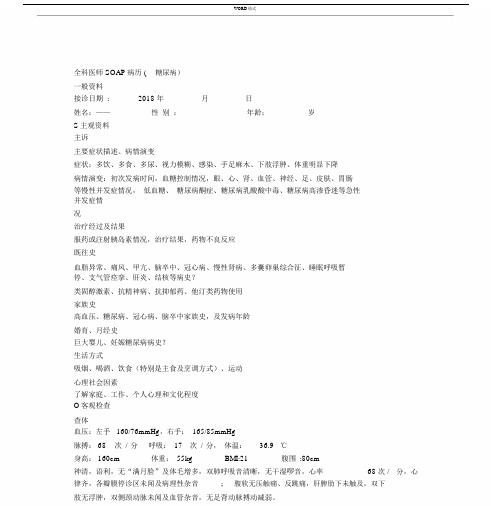
WORD格式全科医师 SOAP病历 (糖尿病)一般资料接诊日期 :2018 年月日姓名:——性别:年龄:岁S主观资料主诉主要症状描述、病情演变症状:多饮、多食、多尿、视力模糊、感染、手足麻木、下肢浮肿、体重明显下降病情演变:初次发病时间,血糖控制情况,眼、心、肾、血管、神经、足、皮肤、胃肠等慢性并发症情况,低血糖、糖尿病酮症、糖尿病乳酸酸中毒、糖尿病高渗昏迷等急性并发症情况治疗经过及结果服药或注射胰岛素情况,治疗结果,药物不良反应既往史血脂异常、痛风、甲亢、脑卒中、冠心病、慢性肾病、多囊卵巢综合征、睡眠呼吸暂停、支气管痉挛、肝炎、结核等病史?类固醇激素、抗精神病、抗抑郁药、他汀类药物使用家族史高血压、糖尿病、冠心病、脑卒中家族史,及发病年龄婚育、月经史巨大婴儿、妊娠糖尿病病史?生活方式吸烟、喝酒、饮食(特别是主食及烹调方式)、运动心理社会因素了解家庭、工作、个人心理和文化程度O客观检查查体血压:左手160/76mmHg,右手: 165/85mmHg脉搏: 68次/分呼吸:17次/分,体温:36.9℃身高: 160cm体重:55kg BMI:21腹围:80cm神清,语利,无“满月脸”及体毛增多,双肺呼吸音清晰,无干湿啰音,心率68 次 /分,心律齐,各瓣膜停诊区未闻及病理性杂音;腹软无压触痛、反跳痛,肝脾肋下未触及,双下肢无浮肿,双侧颈动脉未闻及血管杂音,无足背动脉搏动减弱。
实验室检查及辅助检查空腹、餐后血糖,糖化血红蛋白,血脂、尿酸、尿蛋白,肝肾功能、血脂、眼底、下肢动脉超声、糖尿病足筛查、甲功心理测验SAS焦虑量表HAMD抑郁量表A评价存在危险因素及健康问题危险因素:存在健康问题:血糖控制情况?并发症?并发症专业资料整理WORD格式眼、心、肾、血管、神经、足、皮肤、胃肠等慢性并发症情况,低血糖、糖尿病酮症、糖尿病高渗昏迷等急性并发症情况依从性1. 服药依从性:间断/规律/不服药;2.生活方式管理依从性家庭可利用资源由家属督促其进行慢病管理?P处置计划进一步诊查计划每月随访:体重、空腹餐后血糖、血压、尿常规每3 月随访:糖化血红蛋白、足部检查(足背动脉、神经病变相关检查)每 6 个月随访:尿蛋白 / 肌酐每年复查:身高、 BMI 、心电图、肝肾功能、血脂、眼底、下肢动脉超声、甲功治疗计划药物治疗 :1.注意监测血糖2.胰岛素注射技巧生活方式干预:1. 低盐、低脂饮食(少于 6 克盐, 25克油);2.戒烟、限酒3.精神放松、保持愉快心情;4.饮食控制(总热量、各营养成分比例、简单配餐、水果、烹调方式)5.预防低血糖6.适当运动,每周5次,每次30min,选择适当运动方式如步行、体操等,心率控制在(220-年龄) *0.7次/分左右;根据摄入量调整运动量,餐后90min 运动为宜,注意预防低血糖。
高血压糖尿病门诊病历范文
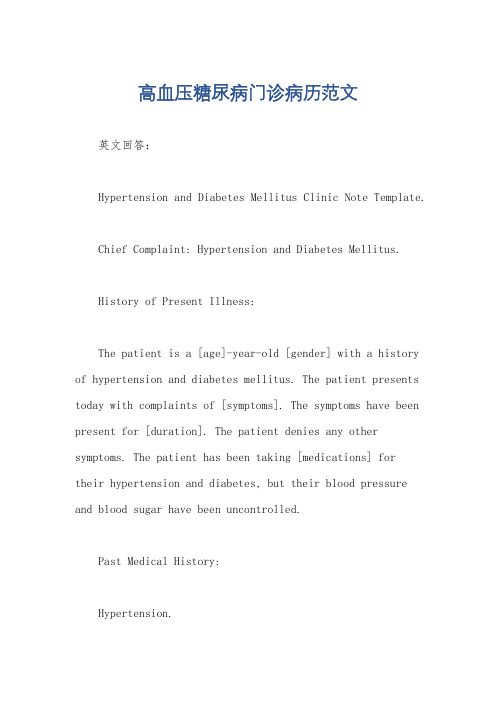
高血压糖尿病门诊病历范文英文回答:Hypertension and Diabetes Mellitus Clinic Note Template.Chief Complaint: Hypertension and Diabetes Mellitus.History of Present Illness:The patient is a [age]-year-old [gender] with a history of hypertension and diabetes mellitus. The patient presents today with complaints of [symptoms]. The symptoms have been present for [duration]. The patient denies any other symptoms. The patient has been taking [medications] fortheir hypertension and diabetes, but their blood pressure and blood sugar have been uncontrolled.Past Medical History:Hypertension.Diabetes Mellitus.[Other past medical history]Social History:The patient is a smoker and drinks alcohol socially. The patient is employed as a [occupation]. The patient lives with [family members].Family History:The patient's father has hypertension. The patient's mother has diabetes mellitus.Physical Examination:Vital Signs:Blood pressure: [blood pressure]Heart rate: [heart rate]Respiratory rate: [respiratory rate]Temperature: [temperature]General:The patient is alert and oriented. The patient is in no acute distress.HEENT:The patient's head is normocephalic and atraumatic. The patient's eyes are normocephalic and atraumatic. Thepatient's ears are normocephalic and atraumatic. Thepatient's nose is normocephalic and atraumatic. Thepatient's mouth is normocephalic and atraumatic.Neck:The patient's neck is supple with no lymphadenopathy.Cardiovascular:The patient's heart is regular rate and rhythm. No murmurs, gallops, or rubs are appreciated.Pulmonary:The patient's lungs are clear to auscultation bilaterally.Abdomen:The patient's abdomen is soft, nontender, and nondistended. No masses or organomegaly are appreciated.Genitourinary:The patient's genitalia are normal.Musculoskeletal:The patient's range of motion is normal. No joint pain or swelling is appreciated.Neurological:The patient's cranial nerves are intact. The patient's motor and sensory examination is normal.Laboratory Data:Blood Tests:Hemoglobin A1c: [HbA1c]Creatinine: [creatinine]Electrolytes: [electrolytes]Lipid Panel: [lipid panel]Urine Tests:Albumin: [albumin]Creatinine: [creatinine]Glucose: [glucose]Assessment:1. Hypertension.2. Diabetes Mellitus.Plan:Medications:1. The patient will be started on [new medication] for their hypertension.2. The patient will be started on [new medication] for their diabetes mellitus.Lifestyle Modifications:1. The patient will be advised to lose weight.2. The patient will be advised to eat a healthy diet.3. The patient will be advised to exercise regularly.4. The patient will be advised to quit smoking.Follow-up:The patient will be followed up in [number] weeks.中文回答:高血压糖尿病门诊病历范文。
糖尿病体格检查病历书写范文

糖尿病体格检查病历书写范文英文回答:I remember one time when I had to write a medical record for a patient who came in for a physical examination for diabetes. The patient, a 55-year-old male, presented with symptoms such as frequent urination, increased thirst, and unexplained weight loss. Upon examination, his blood glucose levels were found to be elevated, indicating possible diabetes.I started the medical record by documenting thepatient's personal information, including his name, age, and contact details. I then proceeded to record the chief complaint, which was the patient's concern about his symptoms and the possibility of having diabetes.Next, I described the patient's medical history, including any pre-existing conditions, such as hypertension or family history of diabetes. I also noted any medicationsthe patient was currently taking. In this case, the patient had a family history of diabetes, which increased his risk for developing the condition.After that, I documented the physical examination findings. I mentioned the patient's vital signs, such as blood pressure, heart rate, and respiratory rate. I also noted any abnormalities or relevant findings, such as the presence of diabetic neuropathy or retinopathy.In addition, I included the results of the laboratory tests that were performed on the patient. These included a fasting blood glucose test, an HbA1c test, and a lipid profile. The results confirmed the diagnosis of diabetes, with elevated blood glucose levels and HbA1c levels above the normal range. The lipid profile also showed abnormalities, indicating the need for further managementof cardiovascular risk factors.Finally, I concluded the medical record by outliningthe treatment plan for the patient. This included lifestyle modifications, such as dietary changes and regular exercise,as well as medication management, which involved initiating oral hypoglycemic agents. I also made a note to schedule a follow-up appointment to monitor the patient's progress and adjust the treatment plan if necessary.中文回答:我记得有一次我需要为一位前来进行糖尿病体格检查的患者书写病历。
糖尿病酮症酸中毒的病历讨论范文

糖尿病酮症酸中毒的病历讨论范文英文回答:Diabetic ketoacidosis (DKA) is a serious complication of diabetes that occurs when the body produces high levels of ketones. Ketones are chemicals produced when the body breaks down fat for energy instead of using glucose. This can happen when there is not enough insulin in the body to help glucose enter the cells.DKA is commonly seen in patients with type 1 diabetes, but it can also occur in patients with type 2 diabetes. It is usually triggered by factors such as illness, infection, or missed insulin doses. The symptoms of DKA can include excessive thirst, frequent urination, fatigue, nausea, vomiting, and abdominal pain.If left untreated, DKA can lead to a life-threatening condition called diabetic coma. Treatment for DKA involves replacing fluids and electrolytes, correcting high bloodsugar levels, and administering insulin. In severe cases, hospitalization may be required.中文回答:糖尿病酮症酸中毒(DKA)是糖尿病的严重并发症,当身体产生高水平的酮体时就会发生。
糖尿病病例分析

糖尿病病例分析糖尿病(Diabetes)是一种常见的慢性代谢性疾病,其特点是高血糖(Hyperglycemia)和胰岛功能不全。
全球范围内,糖尿病患者数量呈快速增长趋势,成为一种严重的公共卫生问题。
本文将通过一个实际的糖尿病病例,来探讨糖尿病的病因、症状、诊断以及治疗方案。
病例描述:患者为一名男性,年龄45岁,体重超过BMI指数标准,有亲属糖尿病家族史。
患者最近感到频繁口渴,尤其在夜间。
他同时还出现了尿频、疲劳和体重下降等症状。
出于对症状的担忧,他前往医院寻求医疗帮助。
糖尿病病因:糖尿病的病因复杂,与遗传、环境和生活方式等多个因素有关。
在这个病例中,患者的家族病史表明可能存在遗传因素。
此外,患者体重超过了BMI指数标准,说明他可能存在肥胖的生活方式。
肥胖是糖尿病的一个主要危险因素,因为它可以导致胰岛素抵抗(Insulin Resistance)。
糖尿病症状:常见的糖尿病症状包括多饮(Polydipsia)、多尿(Polyuria)和多食(Polyphagia)。
患者在夜间频繁口渴可能与高血糖引起的尿频有关。
此外,疲劳和体重下降也是糖尿病常见的症状,这与细胞无法充分利用血糖导致能量不足有关。
糖尿病诊断:对于糖尿病的诊断,常用的方法是血糖检测。
患者在就诊时进行血液检查,结果显示其空腹血糖(Fasting Blood Glucose)水平高于正常范围。
此外,还可以进行糖化血红蛋白(HbA1c)测定,用于评估血糖控制的长期情况。
糖尿病治疗方案:糖尿病的治疗通常包括生活方式干预和药物治疗两个方面。
对于患者来说,重点应放在改善生活方式。
首先,通过控制饮食,避免高糖和高脂食物,正确使用低糖指数食物,控制每日卡路里摄入量。
其次,通过增加身体活动,帮助消耗多余的血糖和脂肪,并提高体内胰岛素的敏感性。
此外,戒烟和限制酒精摄入也是必要的。
药物治疗方面,胰岛素或口服降糖药物可以根据患者具体情况进行选择。
总结:通过这个糖尿病病例的分析,我们可以看到糖尿病是一个复杂的疾病,其病因涉及遗传、生活方式等多个方面。
2型糖尿病 住院病历模板
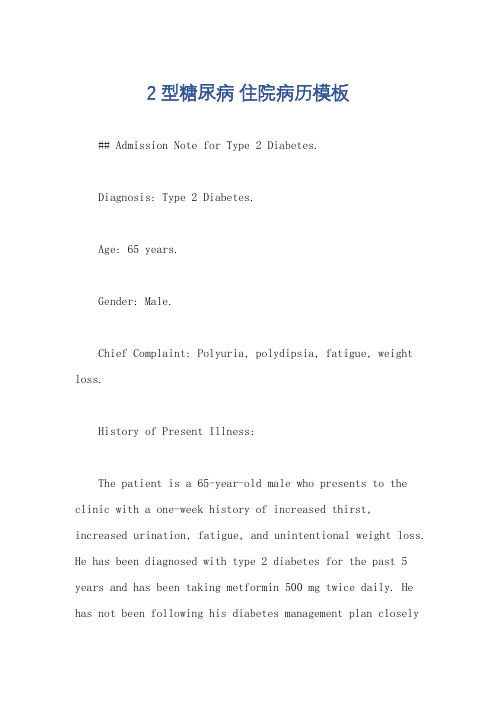
2型糖尿病住院病历模板## Admission Note for Type 2 Diabetes.Diagnosis: Type 2 Diabetes.Age: 65 years.Gender: Male.Chief Complaint: Polyuria, polydipsia, fatigue, weight loss.History of Present Illness:The patient is a 65-year-old male who presents to the clinic with a one-week history of increased thirst, increased urination, fatigue, and unintentional weight loss. He has been diagnosed with type 2 diabetes for the past 5 years and has been taking metformin 500 mg twice daily. He has not been following his diabetes management plan closelyand has been eating a diet high in sugar and carbohydrates. He denies any other symptoms such as blurred vision, pain, or numbness.Past Medical History:Type 2 Diabetes.Hypertension.Medications:Metformin 500 mg twice daily.Social History:The patient is retired and lives with his wife. He is a former smoker and has a 10-pack year history of smoking. He denies alcohol or illicit drug use.Family History:His father and brother both have type 2 diabetes.Physical Examination:Vital signs: Blood pressure: 140/90 mmHg, heart rate: 88 beats/min, respiratory rate: 18 breaths/min, temperature: 98.6°F.General: Obese male in no acute distress.HEENT: Normocephalic and atraumatic. Pupils are equal, round, and reactive to light. Extraocular movements are intact. Oropharynx is clear without erythema or exudate. Neck is supple without lymphadenopathy.Cardiovascular: Regular rate and rhythm. No murmurs, gallops, or rubs. Pulses are palpable in all extremities.Respiratory: Clear to auscultation bilaterally. No wheezes, rales, or rhonchi.Gastrointestinal: Abdomen is soft, non-tender, andnon-distended. Bowel sounds are normoactive. No hepatosplenomegaly.Genitourinary: Genitalia are normal. No masses or tenderness.Musculoskeletal: No joint deformities or swelling. Range of motion is intact.Neurological: Mental status is intact. Cranial nerves are intact. Motor and sensory exams are normal.Laboratory Studies:Blood glucose: 300 mg/dL.Hemoglobin A1c: 8.5%。
2型糖尿病病历范文

2型糖尿病病历范文英文回答:Type 2 diabetes is a chronic condition that affects the body's ability to regulate blood sugar levels. It is characterized by insulin resistance, which means that the body's cells do not respond properly to insulin. This leads to high levels of glucose in the bloodstream.I was diagnosed with type 2 diabetes two years ago. At that time, I had been experiencing symptoms such as frequent urination, increased thirst, and unexplained weight loss. I went to see my doctor, and after some blood tests, I was told that I had diabetes.Since then, I have been managing my condition through a combination of medication, diet, and exercise. I take oral medications to help control my blood sugar levels, and I also monitor my levels regularly using a glucose meter. In terms of diet, I try to eat a balanced meal that includeslean proteins, whole grains, and plenty of fruits and vegetables. I also avoid foods that are high in sugar and carbohydrates. Exercise is also an important part of my routine, as it helps to improve insulin sensitivity and control my weight.Living with type 2 diabetes has its challenges, but it has also taught me the importance of taking care of my health. I have learned to make healthier choices when it comes to food and to prioritize regular physical activity.I have also become more aware of the impact that stress and lack of sleep can have on my blood sugar levels.One of the biggest challenges for me has been managing my blood sugar levels while eating out or attending social events. It can be difficult to find healthy options on restaurant menus or resist the temptation of desserts and sugary drinks. However, I have learned to make smarter choices by opting for grilled or baked dishes instead of fried ones, and by choosing water or unsweetened beverages instead of sugary ones.中文回答:2型糖尿病是一种慢性疾病,影响机体调节血糖水平的能力。
糖尿病病例书写范文大全
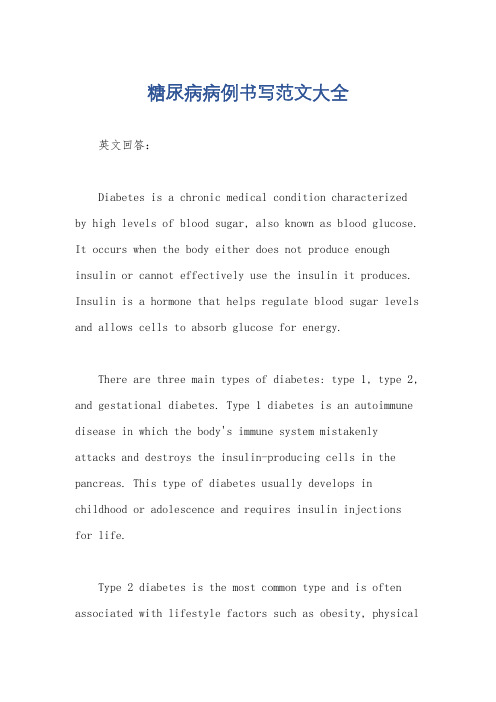
糖尿病病例书写范文大全英文回答:Diabetes is a chronic medical condition characterized by high levels of blood sugar, also known as blood glucose. It occurs when the body either does not produce enough insulin or cannot effectively use the insulin it produces. Insulin is a hormone that helps regulate blood sugar levels and allows cells to absorb glucose for energy.There are three main types of diabetes: type 1, type 2, and gestational diabetes. Type 1 diabetes is an autoimmune disease in which the body's immune system mistakenly attacks and destroys the insulin-producing cells in the pancreas. This type of diabetes usually develops in childhood or adolescence and requires insulin injectionsfor life.Type 2 diabetes is the most common type and is often associated with lifestyle factors such as obesity, physicalinactivity, and unhealthy eating habits. In this type of diabetes, the body becomes resistant to insulin or does not produce enough insulin to maintain normal blood sugar levels. It can usually be managed with a combination of medication, lifestyle changes, and sometimes insulin therapy.Gestational diabetes occurs during pregnancy and usually resolves after giving birth. It is caused by hormonal changes that affect insulin production and utilization. Women with gestational diabetes have an increased risk of developing type 2 diabetes later in life.Managing diabetes involves maintaining blood sugar levels within a target range through a combination of medication, diet, exercise, and regular monitoring. This includes taking prescribed medications, following a balanced diet that is low in sugar and carbohydrates, engaging in regular physical activity, and monitoring blood sugar levels using a glucose meter.Complications of uncontrolled diabetes can includeheart disease, stroke, kidney disease, nerve damage, and vision problems. It is important for individuals with diabetes to work closely with their healthcare team to prevent and manage these complications.中文回答:糖尿病是一种慢性疾病,其特征是血糖水平过高。
关于糖尿病的报告英文作文

关于糖尿病的报告英文作文Diabetes is a chronic metabolic disorder characterized by high blood sugar levels over a prolonged period. It is a global health crisis affecting millions of people worldwide, and its prevalence is on the rise due to factors such as sedentary lifestyles, obesity, and an aging population.There are two main types of diabetes: Type 1 and Type 2. Type 1 diabetes is an autoimmune condition where the body's immune system attacks and destroys the insulin-producingcells in the pancreas. This type usually develops in childhood or adolescence and requires lifelong insulin therapy. On the other hand, Type 2 diabetes is more common and is often linked to lifestyle factors such as poor diet and lack of exercise. It is typically managed through diet, exercise, and sometimes medication or insulin.The symptoms of diabetes can vary but commonly include frequent urination, excessive thirst, fatigue, and blurred vision. If left untreated, diabetes can lead to serious complications such as heart disease, stroke, kidney failure, and nerve damage.Prevention and management of diabetes involve maintaining a healthy lifestyle with a balanced diet and regular physical activity. It is also crucial to monitor blood sugar levels regularly and adhere to prescribed medication or insulin regimens. Public health campaigns aim to raise awarenessabout the risks of diabetes and promote early detection and treatment.In conclusion, diabetes is a serious and growing health concern that requires both individual and societal efforts to manage and prevent. By understanding the causes, symptoms, and management strategies, we can work towards reducing the impact of this condition on individuals and healthcare systems.。
糖尿病患者的临床病例分析
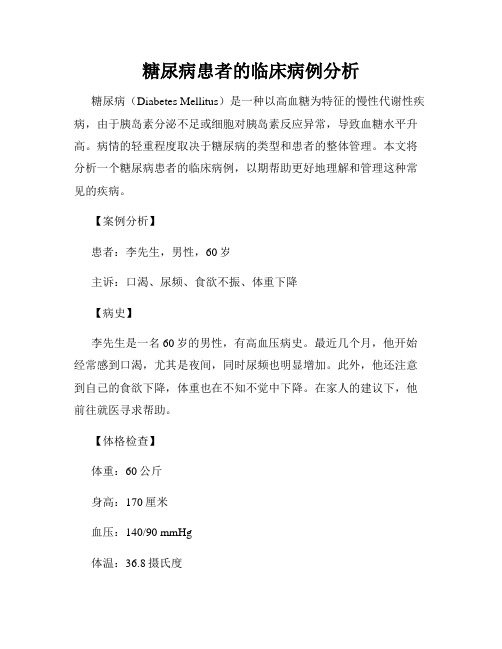
糖尿病患者的临床病例分析糖尿病(Diabetes Mellitus)是一种以高血糖为特征的慢性代谢性疾病,由于胰岛素分泌不足或细胞对胰岛素反应异常,导致血糖水平升高。
病情的轻重程度取决于糖尿病的类型和患者的整体管理。
本文将分析一个糖尿病患者的临床病例,以期帮助更好地理解和管理这种常见的疾病。
【案例分析】患者:李先生,男性,60岁主诉:口渴、尿频、食欲不振、体重下降【病史】李先生是一名60岁的男性,有高血压病史。
最近几个月,他开始经常感到口渴,尤其是夜间,同时尿频也明显增加。
此外,他还注意到自己的食欲下降,体重也在不知不觉中下降。
在家人的建议下,他前往就医寻求帮助。
【体格检查】体重:60公斤身高:170厘米血压:140/90 mmHg体温:36.8摄氏度心跳:80次/分钟【辅助检查】血常规:- 血糖水平:空腹血糖 8.5 mmol/L(正常值:3.6-6.1 mmol/L)尿常规:- 尿糖呈阳性(正常值:阴性)- 尿酮体:阴性【诊断】根据患者的主诉和检查结果,李先生被诊断为糖尿病。
空腹血糖水平超过正常范围,并且尿糖呈阳性,这表明他的身体无法正常利用和调节血糖水平。
【治疗与管理】1. 药物治疗:- 胰岛素注射:考虑到李先生的高血糖水平以及并发症风险,他需要开始胰岛素注射治疗。
在最初的几周中,他可能需要进行频繁的血糖监测,并逐渐调整胰岛素剂量,以确保血糖水平的稳定。
- 口服药物:当李先生的血糖水平得到更好的控制后,他的医生可能会考虑在胰岛素治疗中加入一些口服药物。
2. 饮食管理:李先生需要与专业的营养师合作,制定适合他的糖尿病饮食计划。
这包括合理控制碳水化合物摄入量、增加膳食纤维摄入量、限制饮食中的饱和脂肪和胆固醇含量,并确保足够的蛋白质摄入。
3. 运动计划:定期进行有氧运动,如快走、慢跑、游泳等,有助于控制血糖水平,提高身体代谢能力,减轻体重和改善身体健康状况。
李先生应咨询医生并获得合适的运动计划。
糖尿病酮症酸中毒的病历讨论范文
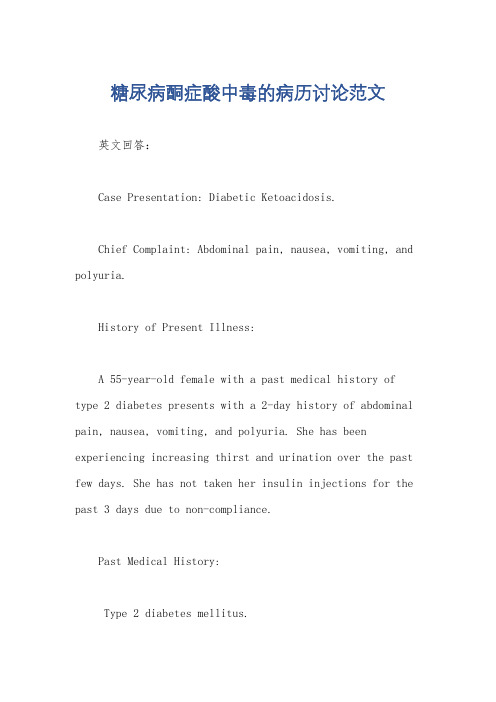
糖尿病酮症酸中毒的病历讨论范文英文回答:Case Presentation: Diabetic Ketoacidosis.Chief Complaint: Abdominal pain, nausea, vomiting, and polyuria.History of Present Illness:A 55-year-old female with a past medical history of type 2 diabetes presents with a 2-day history of abdominal pain, nausea, vomiting, and polyuria. She has been experiencing increasing thirst and urination over the past few days. She has not taken her insulin injections for the past 3 days due to non-compliance.Past Medical History:Type 2 diabetes mellitus.Hypertension.Hyperlipidemia.Vital Signs:Temperature: 99.5°F.Pulse: 120 bpm.Respiratory rate: 28 breaths/minute.Blood pressure: 150/90 mmHg.Physical Examination:General: Appears dehydrated, with dry mucous membranes and flushed skin.Abdominal: Tender to palpation in the epigastric and right upper quadrant regions.Neurological: Alert and oriented x3. Laboratory Data:Blood glucose: 650 mg/dL.Ketones: Large.Arterial blood gas:pH: 7.20。
2型糖尿病系统回顾病历范文

2型糖尿病系统回顾病历范文英文回答:Type 2 diabetes is a chronic condition that affects the way the body metabolizes sugar (glucose). It occurs when the body becomes resistant to the effects of insulin or when the pancreas does not produce enough insulin. I have reviewed a patient's medical record with a diagnosis of type 2 diabetes, and I would like to provide a summary of the case.The patient, Mr. Zhang, a 55-year-old male, presented with symptoms of increased thirst, frequent urination, and unexplained weight loss. His fasting blood glucose level was found to be elevated at 180 mg/dL. Further investigations revealed an HbA1c level of 8.5%, confirming the diagnosis of type 2 diabetes. Mr. Zhang has a family history of diabetes, with his father and two siblings also having the condition.Upon reviewing his medical history, it was noted that Mr. Zhang had a sedentary lifestyle and a poor diet high in refined carbohydrates and saturated fats. He also had a history of hypertension and dyslipidemia, which are common comorbidities associated with type 2 diabetes.To manage his diabetes, Mr. Zhang was advised to make lifestyle modifications, including regular exercise and a balanced diet. He was also prescribed oral antidiabetic medication (metformin) to help control his blood glucose levels. Additionally, he was referred to a dietitian for personalized dietary counseling.During follow-up visits, Mr. Zhang reported improvements in his symptoms and a gradual decrease in his blood glucose levels. He mentioned that he had started incorporating more vegetables and whole grains into hisdiet and had been walking for 30 minutes every day. His HbA1c levels decreased to 6.5% after three months of treatment.In conclusion, Mr. Zhang's case highlights theimportance of lifestyle modifications and medication adherence in managing type 2 diabetes. By making changes to his diet and increasing physical activity, he was able to achieve better glycemic control and improve his overall health.中文回答:2型糖尿病是一种慢性疾病,影响着人体对糖(葡萄糖)的代谢方式。
医学课件:糖尿病(英文版)

技能培训
为患者提供技能培训,如如何使用 胰岛素、血糖监测等。
营养教育
为患者提供营养教育,指导他们如 何合理安排饮食,控制血糖和体重 。
05
糖尿病的案例分析
案例一:青少年糖尿病
总结词: 不良的生活习惯、遗传因素、免疫系统问题以 及病毒感染都可能导致青少年糖尿病。
1. 不良的生活习惯:如不规律的饮食、缺乏运动等都可 能影响胰岛素的正常工作,导致糖尿病。
案例三:妊娠期糖尿病
详细描述
2. 对胎儿的影响:妊娠期糖尿病 可能导致胎儿出现出生时低血糖 、黄疸、呼吸窘迫综合征等并发 症。
总结词: 妊娠期糖尿病指在怀孕期 间出现的糖尿病,可能对母亲和 胎儿的健康产生严重影响。
1. 对母亲的影响:妊娠期糖尿病 可能导致孕妇出现高血压、先兆 子痫、感染等并发症。
糖尿病的药物治疗
口服降糖药
包括胰岛素促泌剂、双胍类、糖苷 酶抑制剂等,适用于不同类型和程 度的糖尿病患者。
胰岛素
适用于1型糖尿病和2型糖尿病的晚 期患者,有短效、中效、长效等多 种类型。
其他药物
如GLP-1受体激动剂、DPP-4抑制 剂等,可用于肥胖或超重糖尿病患 者。
注意
以上内容仅供参考,具体治疗方案 请根据医生建议制定。
2023
医学课件:糖尿病(英文版)
目录
• 糖尿病概述 • 糖尿病的病因 • 糖尿病的诊断与治疗 • 糖尿病的预防与控制 • 糖尿病的案例分析 • 总结与展望
01
糖尿病概述
糖尿病的定义
Diabetes Mellitus (DM): A metabolic disease characterized by chronic hyperglycemia resulting from defects in insulin secretion, insulin action, or both.
糖尿病 英文作文带翻译
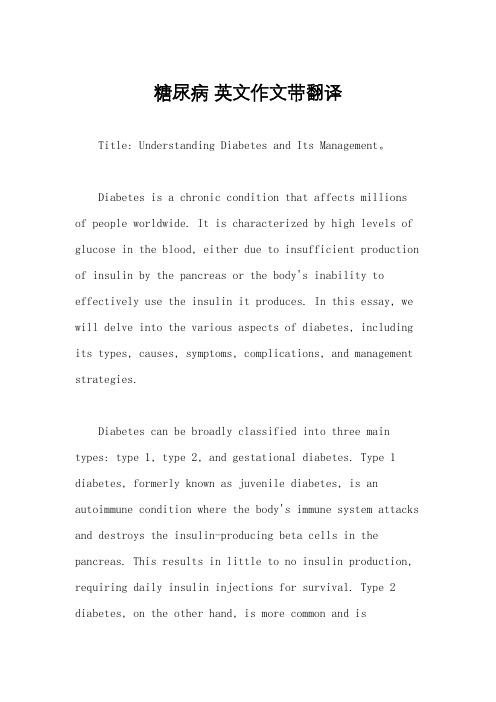
糖尿病英文作文带翻译Title: Understanding Diabetes and Its Management。
Diabetes is a chronic condition that affects millions of people worldwide. It is characterized by high levels of glucose in the blood, either due to insufficient production of insulin by the pancreas or the body's inability to effectively use the insulin it produces. In this essay, we will delve into the various aspects of diabetes, including its types, causes, symptoms, complications, and management strategies.Diabetes can be broadly classified into three main types: type 1, type 2, and gestational diabetes. Type 1 diabetes, formerly known as juvenile diabetes, is an autoimmune condition where the body's immune system attacks and destroys the insulin-producing beta cells in the pancreas. This results in little to no insulin production, requiring daily insulin injections for survival. Type 2 diabetes, on the other hand, is more common and ischaracterized by insulin resistance, where the body's cells do not respond effectively to insulin. This leads to high blood sugar levels, and while the pancreas may produce insulin, it's often not enough to meet the body's needs. Gestational diabetes occurs during pregnancy and usually resolves after childbirth, but it increases the risk ofboth the mother and child developing type 2 diabetes laterin life.The exact causes of diabetes vary depending on the type. Type 1 diabetes is believed to have a genetic predisposition, although environmental factors such asviral infections may trigger its onset. Type 2 diabetes is closely linked to lifestyle factors such as poor diet, lack of physical activity, obesity, and genetics. Gestational diabetes is thought to result from hormonal changes during pregnancy that affect insulin sensitivity.Regardless of the type, diabetes shares common symptoms such as increased thirst, frequent urination, unexplained weight loss, fatigue, and blurred vision. If left untreated, diabetes can lead to serious complications such as heartdisease, stroke, kidney failure, nerve damage, and blindness. Therefore, early detection and proper management are crucial in preventing these complications.Management of diabetes revolves around maintainingblood sugar levels within a target range to prevent hyperglycemia (high blood sugar) and hypoglycemia (lowblood sugar). This often involves a combination of medication, dietary changes, regular exercise, monitoring blood sugar levels, and, in the case of type 1 diabetes, insulin therapy. Medications commonly used to treat type 2 diabetes include oral hypoglycemic agents such as metformin, sulfonylureas, and insulin sensitizers like thiazolidinediones.Diet plays a fundamental role in diabetes management. A balanced diet rich in whole grains, fruits, vegetables,lean proteins, and healthy fats can help regulate blood sugar levels and prevent complications. Carbohydrate counting is often recommended for individuals using insulin to match their insulin dose with their carbohydrate intake.Regular physical activity is also essential for managing diabetes as it improves insulin sensitivity and helps control weight. Aerobic exercises such as walking, cycling, swimming, and strength training are beneficial for lowering blood sugar levels and reducing the risk of cardiovascular disease.In addition to medication, diet, and exercise, monitoring blood sugar levels is vital for adjusting treatment plans and preventing complications. Self-monitoring of blood glucose levels using a glucometer allows individuals to track their blood sugar levels throughout the day and make necessary adjustments to their medication, diet, or physical activity.In conclusion, diabetes is a complex condition that requires lifelong management to prevent complications and maintain overall health. By understanding the different types, causes, symptoms, and management strategies of diabetes, individuals can take control of their health and lead fulfilling lives despite their diagnosis.糖尿病是一种慢性疾病,影响着全球数百万人。
- 1、下载文档前请自行甄别文档内容的完整性,平台不提供额外的编辑、内容补充、找答案等附加服务。
- 2、"仅部分预览"的文档,不可在线预览部分如存在完整性等问题,可反馈申请退款(可完整预览的文档不适用该条件!)。
- 3、如文档侵犯您的权益,请联系客服反馈,我们会尽快为您处理(人工客服工作时间:9:00-18:30)。
Shiyun Kim, PharmD, BCACP, BCPP, CDE
James Lee, PharmD, BCACP
University of Illinois at Chicago College of Pharmacy
Diabetes Cases – July 5, 2017
CASE 1
M.L. is a 48 y.o. Asian female who presents to the Internal Medicine Clinic clinical pharmacist for follow-up regarding hypertension (HTN). She was screened for diabetes at a recent health fair and was told to discuss her blood sugar reading with her health care provider. However, she does not remember the blood sugar reading. She tells you her sister was recently diagnosed with Type 2 diabetes.
PMH: HTN x 6 months, GDM (gestational DM) 7 years ago
PSH: Tubal ligation 7 years ago
FH: Mother: Type 2 DM
Father: HTN
Sister: Type 2 DM
M. Grandmother: Diabetes, unsure what type, was using insulin
SH: Smokes 1ppd x 15 years, occ EtOH, denies illicit substance use
Caffeine: Drinks 2 cups of coffee/ day, 1-2 regular Pepsi sodas/day
Diet: Does not always eat breakfast, usually eats fast food for lunch
NKDA (no known drug allergies)
Medications
HCTZ 25mg po daily
Vitals: Ht 5’5” Wt: 180 lbs (81.7kg) BMI 30 BP 144/82 P 82 R 20 Temp 98.6 F
1.What risk factors does ML have for DM?
2. A Fasting Blood Glucose (FBG) measurement was obtained from ML today: 140mg/dL.
What is ML’s diagnosis?
3.What specific lifestyle modification interventions would you suggest?
4.Which labs should you order?
5.What medication therapy for her blood glucose would you initiate? (state dose and
regimen)
6.How would you optimize her current anti-hypertensive regimen? (state
medication class and monitoring parameters)
7.What specific education should you provide for ML today?
8.When would you follow-up with ML?
CASE 2
ML returns for follow-up appointment. She is unsure if she is eating the best foods to control her BG. She is tolerating her new medications well. She is trying to eat breakfast, but has been mostly been eating a donut or potato chips on her way to work. She is increasing her physical activity to 10 minutes three days a week by walking after work. She has been eating 1 banana and chips for snacks.
She brought in her BG readings.
SMBG:
Fasting BG 160-180mg/dl
After meals 200-240mg/dl
1.What aspects of ML management of diabetes could be improved?
2.How would you adjust ML’s current medication therapy? (Give dose and regimen)
3.What are the clinical benefits of your recommendations?
4.When would you like to follow up with ML?。
